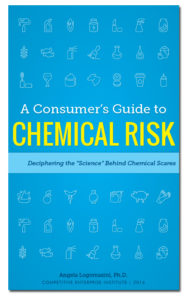So you hear that a chemical doubles cancer risks among a certain segment of the population. What does that really mean? Maybe not as much as you think. Oftentimes, such claims emerge out of an epidemiological study that finds a weak association between a health ailment and a chemical, but such findings do not prove-cause and-effect. In fact, any single study is rarely definitive, which is why researchers and others should always consider the full body of research on a topic or the weight-of-the evidence before sounding the alarm.
Epidemiology involves the study of diseases within human populations and potential causes. Epidemiologists use statistics to compare the relative risk of belonging to one of two or more groups—assessing whether two factors (such as a chemical exposure and a health effect) frequently happen at the same time. Accordingly, these studies by themselves do not establish a cause-and-effect relationship, but the stronger the association, the more compelling the case is for a potential cause-and-effect relationship.
Types of Epidemiological Studies. Researchers employ four main types of epidemiological studies:
- Clinical;
- Cohort;
- Case-control; and
- Ecological.
Clinical studies provide the most reliable results followed by cohort studies, case-control studies, and then ecological studies. Clinical studies rely on experimental collected through controlled experiments, while others rely on observational data from existing sources, such as polling subjects on health history, census data, or other databases.
Researchers measure the strength of associations by assessing the “relative risk” of a chemical, an they calculate that as a risk ratio. A risk ratio of 1 indicates no differences exist between the two groups, and ratios over three indicate that some association between the chemical and the health effects exists, but it still does not demonstrate a cause-and-effect association.
When researches do find an association, they then try to determine whether the finding is statistically significant. Statistical significance is the attempt to quantify the probability that research findings were merely accidental rather than the result a real relationship between two variables in the study.
In addition to the task of finding an association and then proving it statistically significant, researchers face a number of other challenges to establishing the validity of their findings. These include challenges associated with finding a truly random sample, sometime insufficient sample size, confounding factors, recall bias, and, researcher bias. Studies gain greater weight when a number of other factors are present including, sufficent and relevant exposures, peer review,
reproducibility, and most importantly, the findings are supported by the weight of the evidence.
Browse the terms on the sidebar of this webpage for more information and/or download a copy of A Consumer’s Guide to Chemical Risk: Deciphering the “Science” Behind Chemical Scares.


